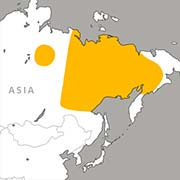Appearance:
Male Baikal teals are more colorful and have a more vibrant plumage than females. Females have a white spot on the base of their bill. Teals' webbed feet and thick feathers make them well-suited for spending long periods of time in water. Their striped and blotchy feathers provide camouflage, helping them blend in with long grasses. The small, tooth-like projections on their bill allow them to filter out food more efficiently than most dabbling ducks.
Size:
A male’s average weight is approximately 1 pound, while females tend to average slightly under 1 pound.
Diet:
These ducks feed on grains, seeds, aquatic invertebrates, algae and aquatic plants.
Reproduction:
This species reaches sexual maturity at age 1. Their breeding season is in May, and they breed once yearly. They are monogamous during each breeding season, and each year they choose a new mate. Baikal teal migrate to swampy woodland and meadow breeding grounds and begin courtship displays. Males “burp” and females gesture by “nod-swimming”.
Females typically lay between four and 10 eggs, which hatch about 24 days later. By August, ducklings are independent from their mothers. Chicks can forage, dive and walk by themselves shortly after hatching, and their mother will only brood them at night and when it gets cold to protect them.
Behavior:
Baikal teal are social animals. They’re often found in large numbers, roosting in large flocks. Known as dabbling ducks, this waterfowl species tends to sit on the water and doesn’t dive. They communicate by using different quacks.
Habitat/Range:
Baikal teal is a species native to eastern Asia, traveling between north and east Siberia to southeast China. While rare, they’ve been seen in Alaska. They can be found in freshwater ponds and pools in taiga and tundra regions. In the winter, this bird can be found in freshwater rivers, lakes and brackish waters.
Median Life Expectancy:
Up to 25 years in the wild
Role in their habitat:
Baikal teal regulate water insect numbers and water plant growth. They're often considered a pest due to their consumption of grain and rice in farmers' fields.
Threats:
Baikal teals are hunted for their feathers, meat, and for sport. They can be preyed upon by dogs, cats, foxes and birds of prey.




